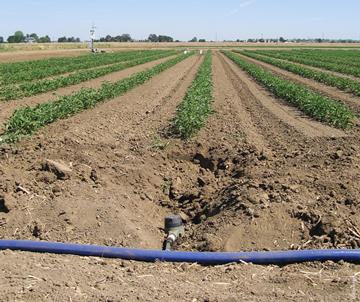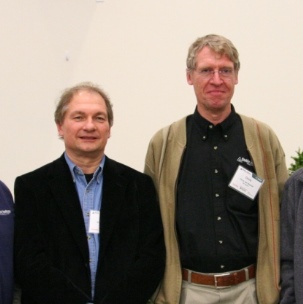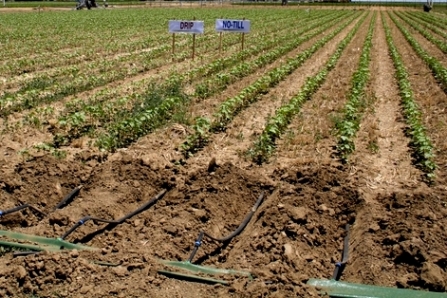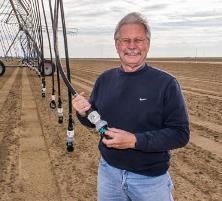Carbon Reduction, the Unrealistic Paris Agreement, and Alternatives for California
Climate scientists from three countries have determined that the carbon reduction goals set at the Paris Agreement in 2015 are not feasible. Regardless of whether the U.S. remains part of the Paris climate accord, scientists at the University of California, Davis, are developing additional agricultural methods to offset increases in atmospheric greenhouse gases, thereby reducing the potential for global warming.

Subsurface drip irrigation in a tomato field at UC Davis. This irrigation method saves water, reduces fertilizer use, and reduces emissions of nitrous oxide, a greenhouse gas. (photo by Martin Burger, UC Davis)
COP21 Conference in Paris, 2015
Chris van Kessel, a plant sciences professor at UC Davis, with colleagues from Arizona, The Netherlands, and the U.K., reported in the journal Environmental Science and Technology that the levels set in the COP21 Conference to slow the increase in atmospheric carbon dioxide (CO2) are not achievable.
The "4 per mille" (4p1000) initiative targets a yearly 0.4 percent increase in global agricultural soil organic carbon (SOC) sequestration. This level of carbon sequestration, if also applied to nonagricultural soils, could compensate for the increases in atmospheric CO2-carbon levels of 4,300 teragrams (4.3 billion tons) per year.
However, the stoichiometry suggests it's not realistic. When carbon is added to soil organic matter, significant amounts of nitrogen are also required to stabilize the carbon. The 4p1000 initiative would require, on global agricultural soils alone, a sequestration rate of 1.3 billion tons of carbon per year, plus 110 million tons of nitrogen.
How much nitrogen is that? A lot. It would be an increase of about 75 percent of current global nitrogen-fertilizer production, or doubling the current symbiotic nitrogen fixation rates in agricultural soils.
"The principle of the 4p1000 goal is very laudable," said van Kessel. "Sequestering carbon leads to more soil organic matter, and that's beneficial -- for crop production, for reducing soil erosion, and increasing the efficiency of crop nutrients. But you cannot sequester carbon without nitrogen, and the large amount of nitrogen required is then not available for crop production."
California Agriculture and Carbon Sequestration
California agriculture is critical to the U.S. food supply and the state's economy, in that California produces two-thirds of the nation's fruits and nuts, and one-third of its vegetables.
To meet the optimistic 4p1000 per year goal not only requires significantly increasing carbon residues in soils, but also slowing carbon decomposition. With the warm year-round climate in California's agricultural areas, soil organic matter breaks down quickly, which counteracts carbon sequestration. Sequestering carbon is more effective in cooler temperate climates with cold winters.
"As much as we in California are working toward the 4p1000 goal, it's a very, very difficult proposition for our warm Mediterranean climate," said van Kessel. "To offset elevated atmospheric CO2 solely by meeting the 4p1000 goal every year is not supported by the facts. We need additional alternatives."

Will Horwath (left) and Chris van Kessel, UC Davis.
Will Horwath, a professor in the Department of Land, Air and Water Resources at UC Davis, says that it's not the best solution to focus solely on the 4p1000 goal to reduce emissions of greenhouse gases.
"The significant levels of nitrogen that must be added to soils to sequester large amounts of carbon is not cost effective and would make agriculture less efficient," said Horwath. "The 4p1000 goal is great in theory, but it would result in the production of more nitrous oxide, which is what we don't want."
Horwath and van Kessel agree that adding even low levels of carbon to the soil is a good thing and has many ecological and production benefits in addition to carbon sequestration.
Alternatives to Carbon Sequestration: Efficient Irrigation, Tillage, and Cover Crops
The use of subsurface drip and micro-irrigation systems not only reduces water and fertilizer use, but also significantly reduces nitrous oxide emissions. Nitrous oxide is a greenhouse gas that contributes to global warming, so reducing its emissions reduces global warming potential.
Recently, more than 95 percent of California tomato growers have switched to subsurface drip irrigation to increase yield while reducing water and fertilizer use. This has also resulted in substantially less nitrous oxide production because excess fertilizers are not used.
Micro-irrigation systems, another relatively new form of irrigation to reduce water use, are being adopted in orchards and vineyards both perennial crops which now make up more than 60 percent of the crop mix in the San Joaquin Valley. The micro-irrigation systems also result in low nitrous oxide emissions.

Multiple subsurface drip irrigation lines in a conservation tillage plot in California. (photo by Jeannette Warnert, UC ANR)
"The technology of subsurface drip irrigation and micro-irrigation was not initially intended to address global warming," said Horwath, "but it has, and significantly."
Tillage and Cover Crops
In annual crop production in California, fields are often tilled regularly, which contributes to the release of sequestered carbon. One method to reduce carbon release from soil is to reduce or eliminate field tillage, and to use cover crops on fields during nonproductive seasons. Many cover crops produce nitrogen for the soil, which helps with carbon sequestration.
Jeff Mitchell, a Cooperative Extension specialist in UC Davis Plant Sciences, has shown that the use of no-till and cover crops, alone or together, can significantly contribute toward reaching the 4p1000 goal. But no-till agriculture and cover crops currently are minimally used in California due to irrigation and management practices, crop market timing, and unfamiliarity with the practices.

Jeff Mitchell, UC Davis and UC ANR
"Making no-till and cover crops cost-effective is quite possible for many of California's annual crops," said Mitchell, "and there are many crop rotations that could benefit. The real challenge is to scale up the adoption of these improved-performance practices more widely in California."
Summary
In summary, locking away carbon in soil may not in itself let California meet the 4p1000 goal, but a combination of carbon sequestration, efficient irrigation systems, and improved tillage and cover crop practices can significantly reduce global warming potential. Ongoing research is helping growers in California move in that direction.
Additional information
Authors on "Sequestering Soil Organic Carbon: A Nitrogen Dilemma," Environmental Science and Technology: Jan Willem van Groenigen (Wageningen University, The Netherlands), Chris van Kessel (University of California, Davis, U.S.), Bruce A. Hungate (Northern Arizona University, U.S.), Oene Oenema (Wageningen University, The Netherlands), David S. Powlson (Rothamsted Research, U.K.), and Kees Jan van Growenigen (University of Exeter, U.K.).
